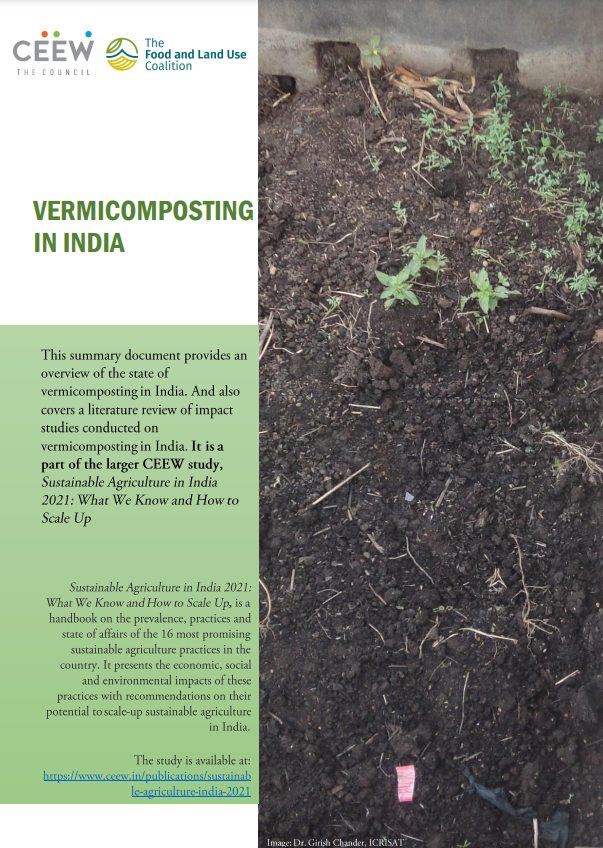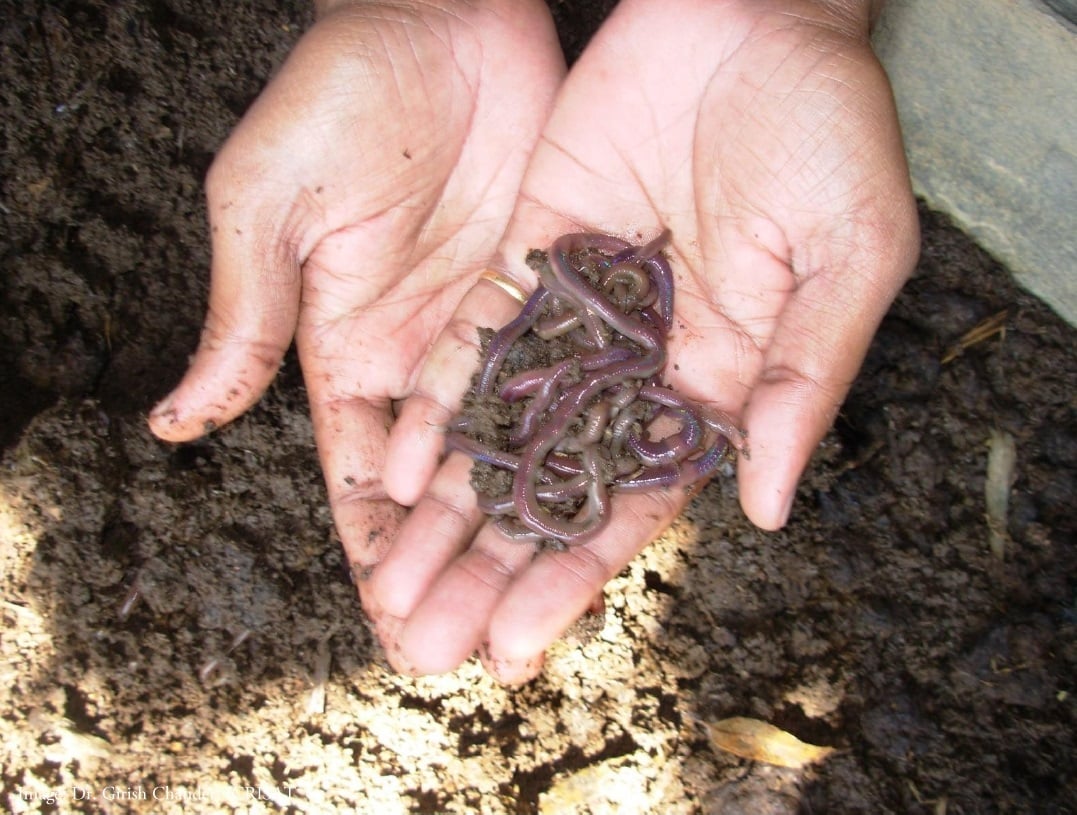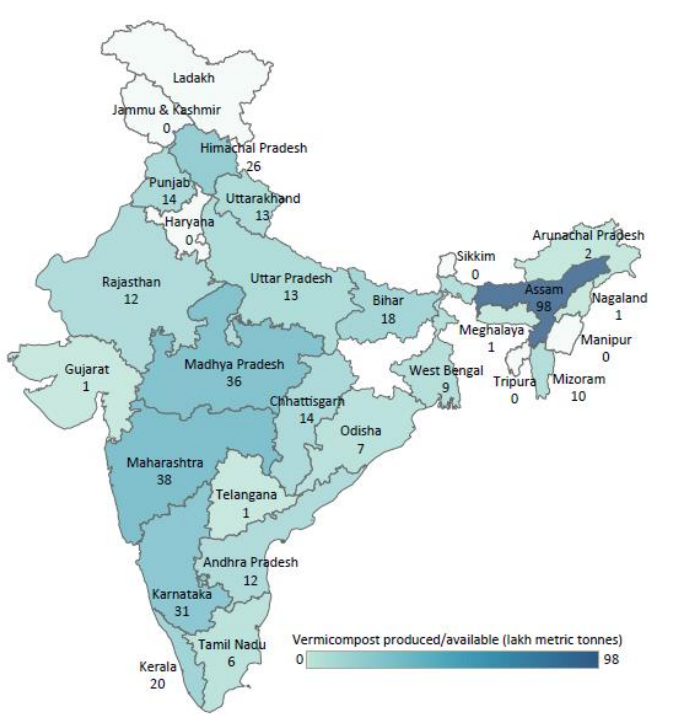




Vermicomposting is a simple biotechnological composting process that uses certain earthworms to enhance the process of waste conversion to produce good-quality compost. The resultant product is a stabilized, uniformly sized substance with a characteristic earthy appearance known as vermicast/ vermicompost 1. Vermicomposting differs from composting in several ways as the earthworms are active between 10-32°C (not ambient temperature but temperature within the pile of moist organic material), and the process is faster than composting. 2

In principle, Vermicomposting adheres to and promotes most of the agroecological elements as defined by the FAO
| ELEMENTS | DESCRIPTION |
|---|---|
| Diversity | Vermicompost enhances soil biodiversity and the population of microbial communities that further improve soil health upon which agricultural production depends, positively impacting human health, flora, and fauna. |
| Co-creation and sharing of knowledge | The vermicompost technique is a blend of traditional or indigenous knowledge infused with scientific ways of producing and applying vermicompost. |
| Synergies | Vermicompost enhances soil biodiversity by promoting beneficial microbes, enhancing plant growth directly by producing plant growth-regulating hormones and enzymes, and indirectly controlling plant pathogens, nematodes, and other pests. |
| Efficiency | It reduces the need to use chemical fertilizers while lowering associated costs. Second, it is a cost-effective measure that transforms biodegradable waste into useful manure using low-cost materials. |
| Recycling | Vermicomposting is one of the best methods to recycle agricultural and domestic waste, allowing for the safe disposal of garbage and preventing environmental pollution that could pollute landfills. |
| Resilience | Vermicomposting is considered a climate-resilient practice as it manages soils and crops in a sustainable manner with fewer chemicals and improves soil health and crop productivity. It also minimizes fertilizer use and related emissions. |
| Human and Social Values | Several vermicompost micro-enterprises run by women’s Self-Help Groups (SHG) and farmers have improved their economic and social status, empowering them in the process. |

This section considers the economic, social, and environmental impacts of vermicomposting.
ECONOMIC IMPACT
There is widespread consensus in India on the positive role of vermicompost in crop productivity. Various case studies from across the country show that yield changes compared to conventional cultivation depend on the quality and quantity of vermicompost and the combinations applied. There is also evidence that a few crops gave higher yields when enriched vermicompost1 was applied rather than standard vermicompost alone or in combination with chemical fertilizers.11,12,13,14
According to several case studies, it is evident that when vermicompost is applied with vermicast (worm castings) it can increase yields significantly compared to conventional fertilizers. For instance, one study shows yield growth of more than 40 percent when applied in wheat.15 Whereas the integrated approach of using half vermicompost and fertilizers did improve yields over the balanced nutrient management approach,2 the rate was lower - ranging from 2 percent to 16 percent for various crops.16 Even fruits such as strawberries and grapes show interesting yield increases (32.7 percent and 23 percent) when vermicompost is applied alone.17 The combination of vermicompost, fertilizer, and biofertilizer gave medium rates of yield growth in rice.18
The practice of producing vermicompost is said to be an economical enterprise compared to chemical fertilizers. Generally, there is direct marketing of vermicompost from producer to consumer which is the strongest channel for marketing the product, but marketing is also done through cooperatives and traders. Vermicomposting used as an alternative to chemicals can significantly reduce input costs.
Estimates show that applying only 6 tonnes per hectare of vermicompost instead of the recommended dose of N, P, K for cereal crop production, can reduce the cost of fertilizer by up to INR 4,000 (USD 55) per hectare and the cost of pesticides by 40 percent in the subsequent three to four years. Further, vermicompost can be sold for INR 10-50 (USD 0.15-0.70) per kg on the e-commerce market. Farmers can also fetch INR 5-30 (USD 0.15-0.45) per kg in the wholesale market in India. These are estimated prices for vermicompost, not earthworms, which sell at INR 300-500 (USD 4-7) per kg.19,20
Water is a very important medium for vermicomposting as it not only sustains the earthworms which are the core of the practice, but it is needed to dissolve the organic waste created by the earthworms into water-soluble substances. Vermicompost also makes the soil more aerated, with a high moisture-holding capacity (nearly 40-60 percent) that can save water and reduce irrigation costs.34
State of available research discussing the impact of conservation farming on various outcomes.
|
Evidence type |
Yield |
Income |
Health |
Gender |
Soil & nutrients |
Water |
Energy |
GHG emissions |
Bio-diversity |
|
Journals |
46 |
4 |
1 |
6 |
47 |
2 |
1 |
2 |
0 |
|
Reports |
1 |
2 |
0 |
1 |
4 |
0 |
0 |
1 |
0 |
|
Articles/Case Studies |
0 |
3 |
0 |
10 |
3 |
0 |
0 |
0 |
0 |
|
Others** |
6 |
6 |
0 |
1 |
2 |
0 |
1 |
1 |
0 |
|
Total |
53 |
15 |
1 |
18 |
56 |
2 |
2 |
4 |
0 |
** Thesis, guidelines, conference papers, etc Source: Authors' compilation
Note — The evidence is from the first 75 results examined in Google Scholar Advanced search and the first 30 results from Google Advanced Search. Only those papers which clearly established the evidence for different indicators were selected.
The following institutions are involved in the research and promotion of conservation farming; a few were consulted for this research:
|
Government institutions |
Research/implementation institutions |
NGOs/Civil society organisations |
|
Central Research Institute for Dryland Agriculture (CRIDA) |
International Crops Research Institute for the Semi-Arid Tropics (ICRISAT) |
Centre for World Solidarity (CWS) |
|
National Centre of Organic Farming (NCOF) |
Tamil Nadu Agricultural University (TNAU) |
Apna Kheti |
|
National Program for Organic Production (NPOP) |
Kerala Agricultural University |
M.S. Swaminathan Foundation (Tamil Nadu), |
|
ICAR-Mountain Livestock Research Institute, Manasbal |
Andhra Pradesh Horticultural University |
PRADAN |
|
Central Research Institute for Dryland Agriculture (CRIDA) |
International Crops Research Institute for the Semi-Arid Tropics (ICRISAT) |
Centre for World Solidarity (CWS) |
Source: Authors' compilation
Note — The stakeholders list is indicative and not exhaustive
1 Vijayabharathi R, Arumugam S, and Gopalakrishnan S. 2015. "Plant growth-promoting microbes from herbal vermicompost". In: Egamberdieva D., Shrivastava S. VA (eds) Plant-Growth-Promoting Rhizobacteria (PGPR) and Medicinal Plants. Springer, Cham, Patancheru, pp 1-18
2 Ibid
3 Pathma J, and Sakthivel N. 2012. "Microbial diversity of vermicompost bacteria that exhibit useful agricultural traits and waste management potential". Springerplus l: 1-19. doi: 10.1186/2193-1801-1-26
4 Wani Suhas P, Chander, Girish and, Vineelav C. 2014. "Bioresources for sustainable plant nutrient management". In: Ramesh C, Raverkar KP (eds) Journal of the Indian Society of Soil Science. Satish Serial Publishing House, New Delhi, pp 123-151
5 Jaybhaye, Maya M., and Satish A. Bhalerao. 2016. "Vermicomposting: A New Trend towards Management of Agricultural Waste (Paddy Straw)." International Journal of Current Research and Academic Review4 (4): 61-67. doi:http://dx.doi.org/10.20546/ijcrar.2016.404.007 6.
6 Kumar Sannigrahi A. 2016. "Major constraints in popularising vermicompost technology in eastern India". Mod Environ Sci Eng2:123-133. doi: 10.15341/mese(2333-2581)/02.02.2016/008
7 El-Khawad, Mohamed, and Rajeev Ahal. 2019. "Business Model: Vermicomposting." New Delhi: Deutsche Gesellschaft fi.ir Internationale Zusammenarbeit (GIZ) GmbH. http://www.birdlucknow.in/wp-content/uploads/2020/03/17-Vermicompost BM.pdf.
8 Geetha M. 2020. Towards Organic Farming-Godhan Nyay Yojana in Chhattisgarh [Power point presentation] https://cdn.cseindia.org/webinar/Godhan-Nyay-Yojana-in-chhattisgarh.pdf
9 National Centre of Organic Farming. 2010. Biofertilizers and Organic Fertilizers Statistics Year 2005-06 to 2009-10. NCOF. Department of Agriculture and Cooperation, Ministry of Agriculture, Govt of India Ghaziabad
10 National Centre of Organic Farming. 2018. Annual Report 2017-18. NCOF. Department of Agriculture and Cooperation, Ministry of Agriculture, Govt of India Ghaziabad
11 Adhikary Sujit. 2012. "Vermicompost, the story of organic gold: A review". Agric Sci 3:905-917.doi: 10.4236/as.2012.37110
12 Pathma J, and Sakthivel N. 2012. "Microbial diversity of vermicompost bacteria that exhibit useful agricultural traits and waste management potential". Springerplus l: 1-19. doi: 10.1186/2193-1801-1-26
13 Swaroop R, Ramawatar. 2012. "Role of vermicompost in crop production- a review". Agric Rev 30:143-146
14 Chander Girish, Wani Suhas P, Gopalakrishnan S, Ankita Mahapatra, Swati Chaudhury, C. S. Pawar, Manoj Kaushal, and A. V. R. Kesava Rao. 2018. "Microbial consortium culture and vermicomposting technologies for recycling on-farm wastes and food production". Int J Recycl Org Waste Agric 7:99-108. doi: 10.1007/s40093-018-0195-9
15 Adhikary Sujit. 2012. "Vermicompost, the story of organic gold: A review". Agric Sci 3:905-917.doi: 10.4236/as.2012.37110
16 Wani Suhas P, Chander, Girish and, Vineelav C. 2014. "Bioresources for sustainable plant nutrient management". In: Ramesh C, Raverkar KP (eds) journal of the Indian Society of Soil Science. Satish Serial Publishing House, New Delhi, pp 123-151
17 Pathma J, and Sakthivel N. 2012. "Microbial diversity of vermicompost bacteria that exhibit useful agricultural traits and waste management potential". Springerplus 1:1-19. doi: 10.1186/2193-1801-1-26
18 Adhikary Sujit. 2012. "Vermicompost, the story of organic gold: A review". Agric Sci 3:905-917.doi: 10.4236/as.2012.37110
19 Amazon. 2020. Vermicompost. https://www.amazon.in/s?k=vermicompost+5+kg&adgrpid=58705216533&ext_vrnc=hi&gclid=Cj0KCQjw8fr7BRDSARisAK0Qqr4gPwhUmW5cIFaPF6AUTpVInC13uxbZL4P9y_nursqOgEWZhpLylKYaA15eEALw_wcB&hvadid=381527321236 &hvdev=c&hvlocphy=9061720&hvnetw=g&hvqmt=b&hvrand=14115080706. Accessed 9 Oct 2020
20 IndiaMART. 2020. Vermicompost - Gandul Khat Latest Price, Manufacturers & Suppliers. https://dir.indiamart.com/impcat/vermi-compost-fertilizer.html Accessed 9 Oct 2020
21 Chattopadhyay Kausik. 2017. "Organic Waste Management by Vermitechnology." Int J Eng Sci Invent 6:1-6
22 El-Khawad, Mohamed, and Rajeev Ahal. 2019. "Business Model: Vermicomposting." New Delhi: Deutsche Gesellschaft fiir Internationale Zusammenarbeit (GIZ) GmbH. http://www.birdlucknow.in/wp-content/uploads/2020/03/l7-Vermicompost-BM.pdf
23 Kumar A, Prakash C.H.B, Brar N.S, and Kumar B. 2018. "Potential of vermicompost for sustainable crop production and soil health improvement in different cropping systems". Int J Curr Microbial Appl Sci 7:1042-1055. doi: 10.20546/ijcmas.2018.710.116
24 Baraskar M, Choudhary S, Wankhede A, and Jain S.K. 2018. "Impact of vermicompost production in terms of income and employment generation". Glob J Appl Agric Res 8:111-116
25 Kumar Sannigrahi A. 2016. "Major constraints in popularising vermicompost technology in eastern India". Mod Environ Sci Eng2:123-133. doi: 10.15341/mese(2333-2581)/02.02.2016/008
26 Wani Suhas P, Chander, Girish and, Vineelav C. 2014. "Bioresources for sustainable plant nutrient management". In: Ramesh C, Raverkar KP (eds) Journal of the Indian Society of Soil Science. Satish Serial Publishing House, New Delhi, pp 123-151
27 Caritas India. 2020. "SHG women benefit by selling vermicompost under Godhan Nyay Yojana". https://www.caritasindia.org/shg-women-beneflt-by-selling-vermicompost-under-godhan-nyay-yojana/. Accessed 30 Sep 2020
28 Kumar Sannigrahi A. 2016. "Major constraints in popularising vermicompost technology in eastern India". Mod Environ Sci Eng2:123-133. doi: 10.15341/mese(2333-2581)/02.02.2016/008
29 Tamil Nadu Agricultural University. 2016. Vermicompost. TNAU http://agritech.tnau.ac.in/org_farm/orgfarm_vermicompost.html. Accessed 24 Jun 2020
30 El-Khawad, Mohamed, and Rajeev Ahal. 2019. "Business Model: Vermicomposting." New Delhi: Deutsche Gesellschaft fiir Internationale Zusammenarbeit (GIZ) GmbH. http://www.birdlucknow.in/wp-content/uploads/2020/03/l7- Vermicompost-BM.pdf
31 Swaroop R, Ramawatar. 2012. "Role of vermicompost in crop production- a review". Agric Rev 30:143-146
32 Manikandan T, Arun M, Meyyappan P, and Kathiravan C. 2018. "An experimental study to assess vermicomposting by using vegetable waste and fruit waste". Int Res J Eng Technol 5:216-220
33 Tamil Nadu Agricultural University. 2016. Vermicompost. TNAU http://agritech.tnau.ac.in/org_farm/orgfarm_vermicompost.html. Accessed 24 Jun 2020
34 Dhanushkodi V, and Porkodi G. 2018. "Impact of Vermicomposting Training Programme on Production, Economics and Employment Generation of Farmer - A Case Study". Asian J Agric Extension, Econ Social 27:1-5. doi: 10.9734/ajaees/2018/ 43208
35 Kalita R, M.D. Das, and Borah S. 2018. "Impact of training programs on the adoption of vermiculture technology practices". Int J Home Sci 4:223-225
36 Srinivasarao C, Venkateswarlu B, and Veeraiah R et al. 2013. Vermicomposting for Efficient Crop Residue Recycling, Soil Health Improvement and Imparting Climate Resilience: Experiences from Rainfed Tribal Regions. Central Research Institute for Dryland Agriculture, Hyderabad
37 Ibid
38 Chattopadhyay Kausik. 2017. "Organic Waste Management by Vermitechnology." Int J Eng Sci Invent 6:1-6
39 Kulkarni, S.J. 2017. "Vermicomposting - a boon for waste minimization and soil quality". Int J Res Rev4:76-81
40 Wani Suhas P, Chander, Girish and, Vineelav C. 2014. "Bioresources for sustainable plant nutrient management". In: Ramesh C, Raverkar KP (eds) Journal of the Indian Society of Soil Science. Satish Serial Publishing House, New Delhi, pp 123-151
41 Chander Girish, Wani Suhas P, Gopalakrishnan S, Ankita Mahapatra, Swati Chaudhury, C. S. Pawar, Manoj Kaushal, and A. V. R. Kesava Rao. 2018. "Microbial consortium culture and vermicomposting technologies for recycling on-farm wastes and food production". Int J Recycl Org Waste Agric 7:99-108. doi: 10.1007/s40093-0l 8-0195-9